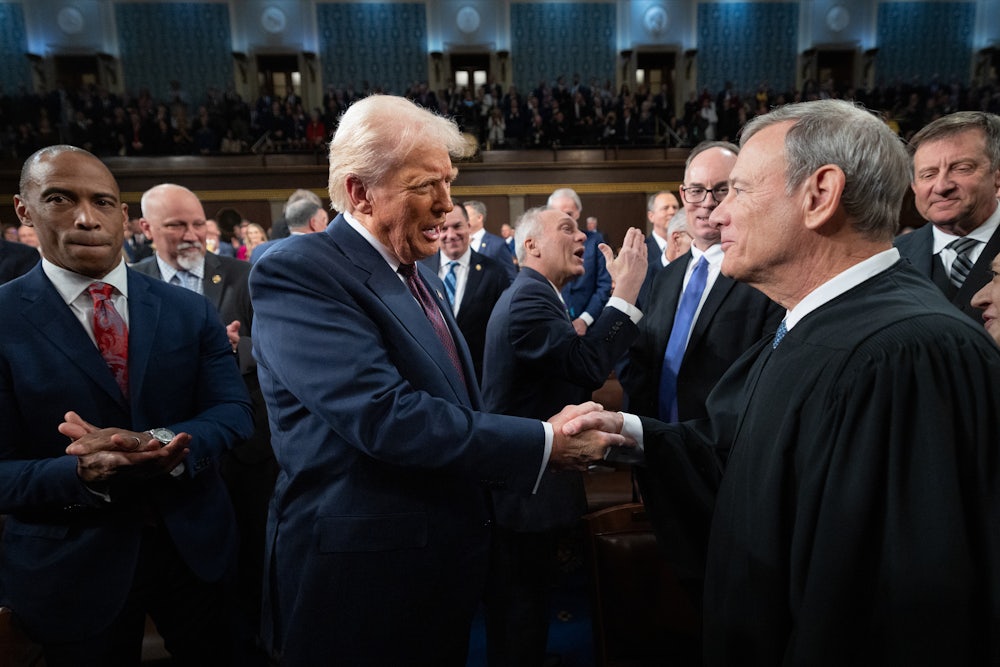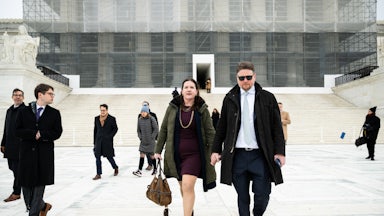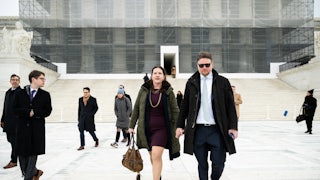The Supreme Court handed a major victory to the Trump administration in its efforts to carry out mass deportations. In a 5–4 vote in Trump v. J.G.G., the justices lifted a temporary injunction against the administration’s use of the Alien Enemies Act to remove Venezuelan nationals who are allegedly connected to an international gang.
In an unsigned order on the court’s emergency docket, the five-justice majority nixed a temporary restraining order by the lower courts on jurisdictional and procedural grounds. It held that habeas petitions, not a Section 1983 lawsuit, were the proper mechanism to challenge the plaintiffs’ detention. “The detainees are confined in Texas, so venue is improper in the District of Columbia,” the court held.
The ruling drew an impassioned dissent from the court’s three liberal justices, which was joined in part by Justice Amy Coney Barrett. “The government’s conduct in this litigation poses an extraordinary threat to the rule of law,” Justice Sonia Sotomayor wrote in her dissent on behalf of the others. “That a majority of this court now rewards the government for its behavior with discretionary equitable relief is indefensible.”
Justice Ketanji Brown Jackson wrote separately to decry the majority’s “fly-by-night approach” as dangerous. She also made a pointed reference to the court’s past sign-offs on abusive practices. “At least when the court went off base in the past, it left a record so posterity could see how it went wrong,” she wrote, citing Korematsu v. United States, the court’s infamous 1944 ruling on Japanese American internment.
The court’s ruling was not a complete defeat for the plaintiffs. In reaching its decision, the court also held that Alien Enemies Act detainees must receive advance notice and hearings where they can challenge their removals. But that will likely prove an insufficient solution to address the legal and constitutional problems that arose from the Trump administration’s conduct in these cases—conduct that the court’s conservative majority has now effectively rewarded.
The case involves five unnamed detainees currently held by the U.S. government. In March, Trump issued an executive order that invoked the Alien Enemies Act, a Founding-era law that was part of the Alien and Sedition Acts, to remove any Venezuelan nationals from the country who are alleged to be members of Tren de Aragua, an international criminal organization. The AEA has been largely moribund for the last 200 years.
Invoking the AEA is a sharp departure from ordinary deportations, which are carried out under the Immigration and Nationality Act and require certain procedural safeguards before they can be carried out. The Trump administration argued that the AEA allowed it to remove anyone in the targeted group from the country without administrative hearings or further judicial review beyond habeas claims. (More on that in a minute.)
The detainees sued the Trump administration to stop their removal under the AEA. Their lawyers noted that the government’s invocation of the AEA is almost certainly illegal under the “plain text” of the statute, which allows it to be invoked only after a “declared war” or an “invasion or predatory incursion” by a “foreign nation or government.”
That should have posed an obstacle to the Trump administration, since the Venezuelan government has neither declared war on the United States nor mounted a military invasion of its territory. “The president’s effort to shoehorn a criminal gang into the AEA, on a migration-equals-invasion theory, is completely at odds with the limited delegation of wartime authority Congress chose to give him through the statute,” the detainees’ lawyers told the justices.
The Justice Department, for its part, railed against the lower courts for interfering with the removals. “This case presents fundamental questions about who decides how to conduct sensitive national-security-related operations in this country—the President, through Article II, or the Judiciary, through [temporary restraining orders],” it claimed in its request for the justices to intervene. “The Constitution supplies a clear answer: the President. The republic cannot afford a different choice.”
In its unsigned four-page majority order, the Supreme Court largely sided with the Trump administration. It lifted the lower courts’ temporary restraining order by holding that the detainees had sought relief through the wrong legal mechanism. Instead of requesting a temporary restraining order on behalf of themselves and all similarly affected detainees, the majority held that they should have filed habeas petitions with the nearest federal courts to review their detention.
“Regardless of whether the detainees formally request release from confinement, because their claims for relief ‘necessarily imply the invalidity’ of their confinement and removal under the AEA, their claims fall within the ‘core’ of the writ of habeas corpus and thus must be brought in habeas,” the justices in the majority wrote, quoting from precedent. While the order is unsigned, the lineup of the dissenting justices means that the majority consists of Chief Justice John Roberts and Justices Clarence Thomas, Samuel Alito, Neil Gorsuch, and Brett Kavanaugh.
At the same time, the court handed the Trump administration what could be a setback by holding that the government must provide targeted detainees with certain due-process protections before removing them because Trump’s order and the text of the AEA limit its applicability to certain groups—Venezuelan nationals who are (1) members of TdA, (2) not green card holders or U.S. citizens, and (3) not younger than 14 years old. (The age requirement is a textual one from the AEA itself.)
“More specifically, in this context, AEA detainees must receive notice after the date of this order that they are subject to removal under the Act,” the court explained. “The notice must be afforded within a reasonable time and in such a manner as will allow them to actually seek habeas relief in the proper venue before such removal occurs.”
Those protections should be a valuable tool for wrongfully targeted detainees who face removal under the AEA. But they may prove to be either insufficient or illusory due to the other half of the court’s ruling. The Trump administration enacted the order in such a way that it hoped to avoid judicial review altogether: first by circulating the executive order internally without public notice, then by detaining the targets and placing them on flights to El Salvador before their lawyers could intervene, and then by refusing to turn the planes around in midair when ordered to do so by a federal judge.
“The Government’s plan, it appeared, was to rush plaintiffs out of the country before a court could decide whether the president’s invocation of the Alien Enemies Act was lawful or whether these individuals were, in fact, members of Tren de Aragua,” Justice Sonia Sotomayor wrote in her dissent. “Plaintiff J. G. G., for example, had no chance to tell a court that the tattoos causing DHS to suspect him of gang membership were unrelated to a gang.”
Federal officials have already shuffled around detainees in other cases in ways that could foil their efforts to contact lawyers or file timely petitions. The five plaintiffs in this particular case are also being detained at an Immigration and Customs Enforcement facility in Texas, perhaps because the federal judges there are more likely to be sympathetic and deferential to the Trump administration’s efforts.
The most concerning aspect is the fate of the dozens of detainees who were sent to El Salvador’s CECOT prison, where the Salvadoran government is indefinitely detaining them. There are multiple reports of detainees being sent there without any proven TdA connections or Venezuelan nationality. But there is no federal district court for El Salvador where a habeas petition could be filed, and in another case, the Trump administration is disavowing any ability whatsoever to free prisoners from the Salvadoran-run facility.
The Supreme Court will likely render a decision on that case in the coming days. Sotomayor did not tip the court’s hand on how it will decide that case, but she underscored the high stakes of the justices’ decision in the two cases. “The Government’s resistance to facilitating the return of individuals erroneously removed to CECOT only amplifies the specter that, even if this Court someday declares the president’s proclamation unlawful, scores of individual lives may be irretrievably lost,” she wrote.
Sotomayor, joined by Justices Elena Kagan, Jackson, and (in part) Barrett, rejected the court’s reasoning on habeas claims on both the merits and on its hasty and slapdash approach to the question. Sotomayor warned that the court had reached its conclusion “without oral argument or the benefit of percolation in the lower courts, and with just a few days of deliberation based on barebones briefing.”
She also noted that the court had leapfrogged the lower courts’ own proceedings on the question to reach its conclusion. “At the very least, the question is a thorny one, and this emergency application was not the place to resolve it,” Sotomayor wrote. “Nor was it the Court’s last chance to weigh in.” Barrett joined this portion of her dissent as well, reflecting her broader unease with the outsize role of the shadow docket in modern Supreme Court workings.
Perhaps the most important portion of Sotomayor’s dissent, however, came when she reiterated the notice requirement for future AEA removals. She noted that all nine justices agreed on the due-process requirement and said that future failures to provide it would amount to defiance of the high court itself. “To the extent the Government removes even one individual without affording him notice and a meaningful opportunity to file and pursue habeas relief, it does so in direct contravention of an edict by the United States Supreme Court,” she emphasized.
Whether that will deter the Trump administration from engaging in future evasive tactics is unclear. The government’s approach to this case is shaped by its willful efforts to evade and undermine the judicial branch and that branch’s ability to ensure that the government follows the law and the Constitution. Previous generations of the Supreme Court held litigants ranging from Southern segregationists to President Richard Nixon accountable for their defiance or near-defiance of federal court orders. This time around, the conservative majority has rewarded it.










